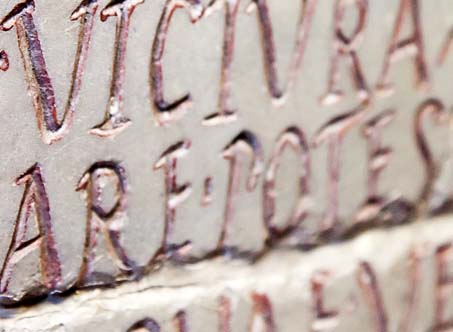In Ancient Rome, much was going on with the Republic and this new found government called for structure to ensure a successful government. This government would need to develop a systems that would help protect the interest of those involved. This became the writing down of laws. Anything not written down can cause doubt and uncertainty. Additionally, laws cannot be enforced if there is no written documentation to assist leaders and officials. Not possessing written down laws also made Ancient Roman citizens angry because many of them were getting punished for breaking laws they did not know existed. This is why Ancient Rome adopted the practice of writing laws, policies, and regulations down. Ancient Rome made officials responsible for enforcing these laws.
Rome’s first written law code was created in 450 BC on twelve bronze tablets. These tablets were put on display in the Forum so all Ancient Roman citizens could see and understand them. This was known as the law of the Twelve Tables. It is important to remember that as the Ancient Roman Empire expanded and society changed, the tablets became a steady symbol of Ancient Roman law.
The 12 Tables
The 12 Tables was Ancient Rome’s attempt to write down laws and create a Code of Law like most advanced civilizations did. The 12 Tables would be similar to what the United States has today called The Bill of Rights. These laws stood as the foundation of Ancient Roman law. Roman law would start from these 12 tablets in 451 B.C. and last a century until the Corpus Juris Civilis in 529 A.D. The Corpus Juris Civilis was also known as the Code of Justinian and was a collection of theories of laws and study. This was very different from the 12 tables because it hoped to get a deeper understanding of legal system and was much more complex. It should also be noted that the 12 Tables are the earliest known written material from Ancient Rome. Not much remains of these laws but fragments that were found throughout history.
These 12 Tables were created by a commission of 10 men known as decemviri which were appointed in 455 B.C. The decemviri were created to ensure civil rights between the common people known as plebeians, and the well respected elite known as the patricians. The plebeians also known as Plebs were shopkeepers, skilled and unskilled workers, and crafts people. The patricians included both natural and adopted members of society and consisted of the high administrative officials and the extremely privileged. The 12 tables were not meant for slaves in Ancient Rome because they were not considered citizens at that time.
These 12 tables came about because of the long struggle between the common people (plebeians) and the respected elite of Ancient Rome (patricians). Formerly, Ancient Rome consisted of wealthy land owning citizens who had power and the right to vote. It was not until the patricians made up most of the ruling class that laws were created to protect their own interest. These laws were enforced by the magistrates and the two consuls. The Roman magistrates were elected officials in Ancient Rome.
The 12 tables were created in 451B.C. which comprised of the first 10 tables. Later on, two more tables would be added to make what we know as The 12 Tables. In 450 B.C. these 12 tables would be formally posted so Ancient Roman citizens could review them. It was believed that the 12 tables were posted on bronze tablets in the Ancient Roman forum which was at the center of the city of Ancient Rome. Some also suggest the 12 Tables were put on pieces of stone. However, little archeological evidence exists on this matter. Posting the 12 Tables in the Roman forum allowed citizens to become familiar with these laws. Citizens being able to understand the laws helped them to protect themselves against corruption. For example, if a citizen was being accused of something, they would know what the law says and what they would need to do in order to defend themselves. Furthermore, it was a citizen’s duty to know and obey these laws.
What is very unique about the 12 Table laws is the fact that they were not a reform from prior Ancient Roman laws. Instead, these 12 Tables recognized the privileges of the patrician, who were leaders of important families and clans. Patricians were a major part of the Senate of Ancient Rome. Therefore, Patricians had some control in how the law favored them. These laws also gave protection of certain rights, which was very innovative thinking during this time period. This was remarkable for the time because it gave liberty for Ancient Romans in respect to testamentary rights and contracts.
Much of the 12 tables are only random quotations because they only exist through references in later juridical writings. The 12 tables were later superseded by changes in Ancient Roman law, but they were never completely eliminated. Today we look at these 12 tables as very forward thinking for that time era as most societies were ruled by a monarch that had ultimate control, like the Pharaohs of Ancient Egypt.


